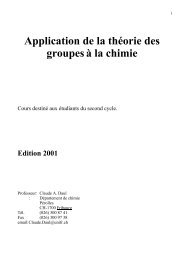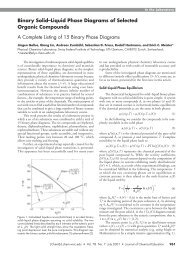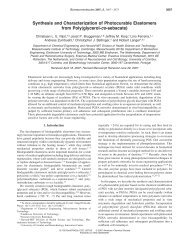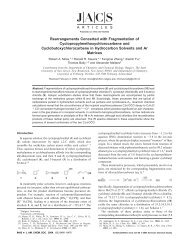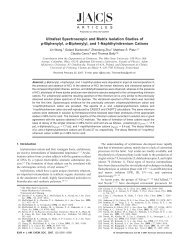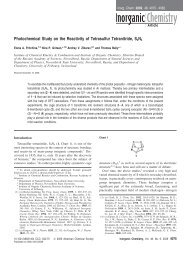Reversible Interconversion between Singlet and Triplet 2-Naphthyl ...
Reversible Interconversion between Singlet and Triplet 2-Naphthyl ...
Reversible Interconversion between Singlet and Triplet 2-Naphthyl ...
You also want an ePaper? Increase the reach of your titles
YUMPU automatically turns print PDFs into web optimized ePapers that Google loves.
H J. Am. Chem. Soc. Zhu et al.Table 3. Excited-State Energies (∆E) <strong>and</strong> Oscillator Strengths (f)of BHT, BHT-COOMe, <strong>and</strong> BBT-COOMe a by INDO/S-CI bBHT BHT-COOMe BBT-COOMeexcited state ∆E,eV f ∆E,eV f ∆E, eV f2 1 A 4.60 0.01 4.47 0.04 3.16 0.033 1 A 4.68 0.12 4.52 0.19 3.52 0.174 1 A 4.99 0.10 4.86 0.14 4.36 0.145 1 A 5.55 0.05 5.35 0.03 4.65 0.03aAt the B3LYP/6-31G* geometries. b Including singly <strong>and</strong> doublyexcited configurations.Figure 8. Schematic B3LYP/6-31G* potential energy surfaces for therearrangement of 2-naphthylcarbene <strong>and</strong> its carbomethoxy derivative,NCC, by cyclization to the tricyclic cyclopropenes, BHT <strong>and</strong> BBT,<strong>and</strong> the subsequent ring opening to the bicyclic allenes, BCH <strong>and</strong> BCT.All energies are relative to the singlet states of the carbenes <strong>and</strong> includezero-point energy corrections (total energies <strong>and</strong> Cartesian coordinatesof all structures are available in Supporting Information).tral in the COOMe derivative. Concomitantly, the calculatedthermal barrier for the reverse reaction decreases from 16 kcal/mol for BHT f 1 2NC to 11.3 kcal/mol for BHT-COOMe f1 NCC.Although the above predictions could be in error by (at most)a few kilocalories per mole, we note that the calculated barrierfor the BHT-COOMe f NCC rearrangement is ∼6 kcal/molhigher than that calculated for the analogous BHD f OCDrearrangement. 100 Both rearrangements take place with similarhalf-lives in Ar, 101 an observation that is inconsistent with theB3LYP prediction for the relative rates of the thermallyactiVated rearrangements. However, the possibility that theBHT-COOMe f NCC rearrangement occurs by quantummechanical tunneling cannot be excluded, although this wouldseem to be rather unlikely in view of the large motion that theatoms of the COOMe group have to undergo in this process.(In a tunneling process, the reaction rate is more sensitive tobarrier width than to barrier height.) Nevertheless, the thermalreactivity of the intermediate does not unequivocally rule out(99) Our calculations revealed a discrepancy in the earlier computationalstudy by Xie et al. 78 Our value of ∆E(BCH-BHT) ) 3.0 kcal/mol disagreeswith the value of 1.4 kcal/mol which can be gathered from Table 2 of ref78 (both by B3LYP/6-31G* after ZPE correction). The reason is that forBCH (16 in the previous study) the ZPE difference of 0.8 kcal/mol wassubtracted instead of added to the energy difference to triplet 2-naphthylcarbene.The B3LYP/6-31G* entry for 16 should be 3.4 kcal/mol insteadof 1.8 kcal/mol.(100) To validate the B3LYP/6-31G* procedure for this type of application,we calculated the barrier for the BHD-OCD rearrangement. 37 AfterZPE correction, this turned out to be 5 kcal/mol at 0 K, 1.7 kcal/mol lowerthan a recent CASSCF/CASPT2 calculation. 73 If compared to the experimentalE a of 2.6 kcal/mol for the BHD-OCD rearrangement, 72b evenB3LYP appears to overestimate the barriers for such reactions.(101) S<strong>and</strong>er et al. reported a half-life of 165 ( 30hat9K; 72b we found∼48hat12K.BHT-COOMe as the photoproduct of 3 NCC. In contrast, thespectroscopic evidence provided below for excluding BHT-COOMe (<strong>and</strong> other possible photoproducts) is compelling.First, the reversible interconversion with 3 NCC involves nodetectable change in the IR spectrum <strong>between</strong> 1670 (CdOstretching frequency of 3 NCC) <strong>and</strong> 2120 cm -1 (CdCdOstretching frequency of 2-naphthylmethoxyketene). The distinctiveCdC stretching vibration of parent BHT occurs around1750 cm -1 , 71 <strong>and</strong> according to B3LYP/6-31G* frequencycalculations on BHT <strong>and</strong> its COOMe derivative, 37 carbomethoxysubstitution shifts this b<strong>and</strong> by ∼40 cm -1 to higher energy, (i.e.,it would be expected at ∼1800 cm -1 in BHT-COOMe).However, the first noticeable change in the IR spectrum occursat 1660 cm -1 , i.e., some 90 cm -1 below the occurrence of theCdC stretching vibration in BHT. This would imply a completefailure of the B3LYP/6-31G* model for calculating vibrationalspectra, which would be very surprising in view of the manysuccesses that have recently been reported. 76,102Second, BHT shows no optical absorptions at longer wavelengthsthan 350 nm, 71 in accord with expectations for itsphenylbutadiene chromophore. To place an estimate on theinfluence of the COOMe group, we carried out INDO/S-CIexcited-state calculations (Table 3) which actually predicthypsochromic shifts of the first two electronic transitions oncarbomethoxy substitution. (Note that INDO/S-CI predicts theposition of the first UV b<strong>and</strong> of BHT at 270 nm 71 (4.6 eV)quite accurately.)Third, we can exclude formation of the other possiblevinylcarbene-cyclopropene rearrangement product, i.e., theCOOMe derivative of 3,4-benzobicyclo[4.1.0]hepta-2,4,6-triene(BBT-COOMe). This species would be expected to show thestrong 350-400-nm (3.1-3.5 eV) absorptions that are typicalfor o-quinoid chromophores, 103 in accord with INDO/S-CIcalculations (see last columns of Table 3). Parent BBT has beenruled out on the same grounds in the recent study of thephotorearrangement of 2-naphthylcarbene. 71 Apart from that,BBT-COOMe is calculated to lie ∼17 kcal/mol higher in energythan BHT-COOMe; hence its formation cannot compete withthat of the latter isomer due to loss of aromaticity. The absenceof absorptions that are typical for o-quinoid chromophores alsoprovides evidence to exclude the o-quinoid cycloheptatetraenederivative BCH-COOMe (Figure 8) as the photoproduct of3 NCC. Finally, BCT-COOMe is excluded as the photoproductof 3 NCC because the rearrangement of BCT-COOMe f NCCis calculated to be substantially endothermic (Figure 8).(102) Rauhut, G.; Pulay, P. J. Phys. Chem. 1995, 99, 3093.(103) McMahon, R. J.; Chapman, O. L. J. Am. Chem. Soc. 1987, 109,683.




